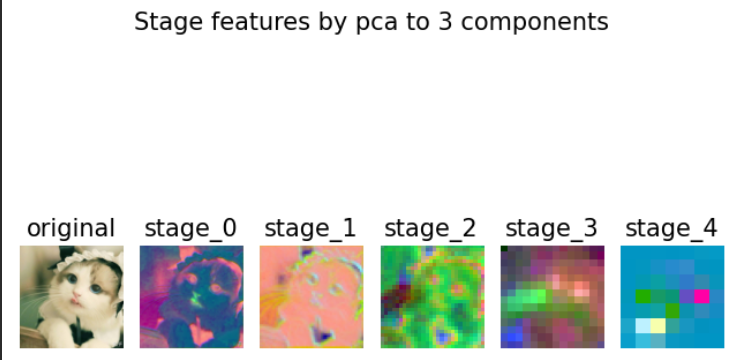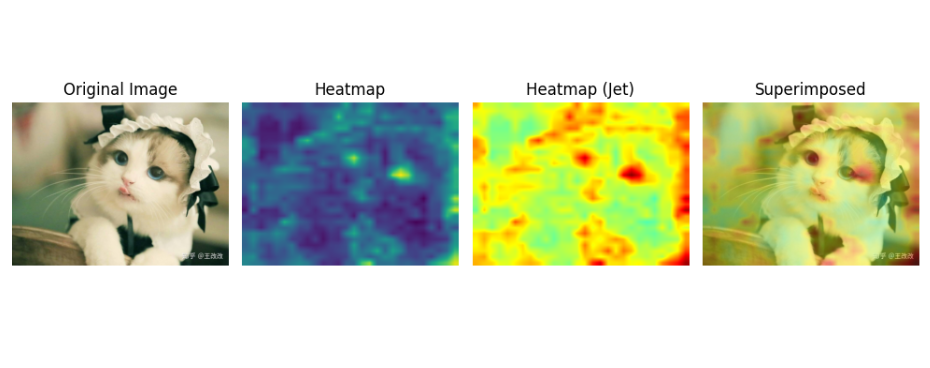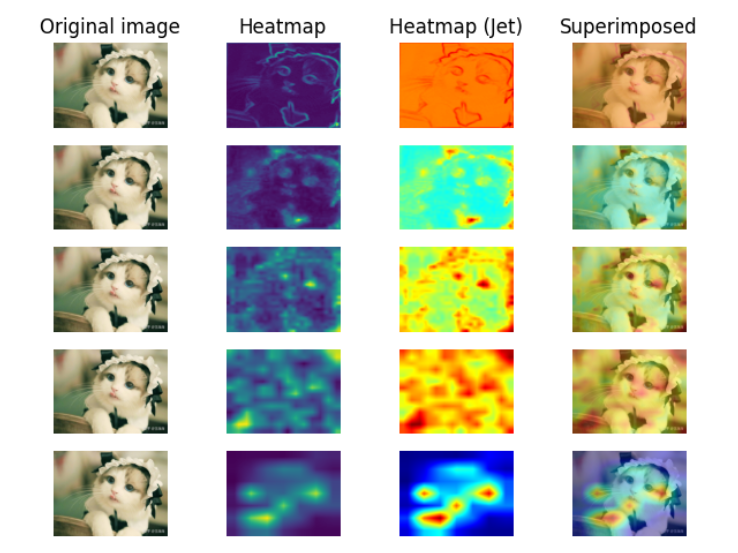最近在尝试可视化一些特征的工作;其中timm库提供丰富的backbone主干模型,模型接口标准(经常可以看到将timm的backbone用在yolo等模型改进中),帮助很多现有工作减少模型搭建工作量,是一些简单网络搭建的起手式,也非常方便做一些backbone的对比工作。
过程说明
部分函数来自于Featup项目,非常感谢他们的工作;
下面的过程结合resnet50说明
- timm创建模型,和对图像做预处理(调整size等)
features_only=True 只拿特征
timm_model = timm.create_model(timm_model_name, pretrained=True, features_only=True)
image = Image.open(image_path, mode='r')
data_config = timm.data.resolve_model_data_config(timm_model)
# print(data_config)
timm_transforms = timm.data.create_transform(**data_config, is_training=False)
timm_unnorm = UnNormalize(list(data_config['mean']), list(data_config['std']))
image_transformed = timm_transforms(image).unsqueeze(0)-
模型做一次前向forward,拿到各个阶段的特征stage_features
timm_model.cuda() image_cuda = image_transformed.cuda() stage_features = timm_model(image_cuda) -
各阶段输出的特征通常具有很多通道数(64,128,256,512,1024 ...),使用PCA进行降维处理(维度数暴露dim参数,可供调整),便于可视化
[stage_feature_pca], _ = pca([stage_feature], 9)
==如有问题,需要帮助,欢迎留言、私信或加群 交流【群号:392784757】== -
热力图基于原始特征,未做PCA,在通道维度进行累加,然后在通道维进行均值化,得到单通道的特征平均图,进一步 /np.max() 归一化到[0,1] 得到热力图
for c in range(feature_map.shape[1]): heatmap += feature_map[:, c, :, :] heatmap_np = np.mean(heatmap.cpu().numpy(), axis=0) heatmap_np = np.maximum(heatmap_np, 0) heatmap_np /= np.max(heatmap_np) -
plot_timm_model_stage_features 绘制各阶段的PCA降维特征图

-
cv_show_single_feature_heatmap 可视化某一阶段的特征热力图情况,提供 stage 参数指定


-
cv_show_all_feature_heatmap 可视化各个阶段的特征热力图情况

-
最终运行完,可得到4张图,分别是 所有阶段特征图、某一阶段的热力图,对应某一阶段热力图和原始图像融合图,所有阶段特征图

01来自 plot_timm_model_stage_features ;02 、03来自cv_show_single_feature_heatmap;04来自cv_show_all_feature_heatmap
上面对应有附图,这里仅做说明,不再重复展示
如有问题,需要帮助,欢迎留言、私信或加群 交流【群号:392784757】
不足之处
当前代码仅在提供的官方模型下进行使用;对于自行训练后的timm模型未做测试(如果只是在timm做微调,应该没有问题),以及在基于timm搭建的网络结构中,这一可视化代码只能做参考,还需要进一步结合网络结构和训练过程做调整修改;
也还算是一个小小的工作,在特征图可视化、热力图可视化等方面希望能对你的工作有所启发,帮助!欢迎一起交流有关这一方面的内容!
完整代码
300多行 完整代码(搭配好能使用timm的环境即可使用,下载的模型调整了位置放在了 当前文件夹下,只需提供模型名称和图片)
# -*- coding: UTF-8 -*-
"""
@File :timm_feature_visualize.py
@Author :cc&uu qq 392784757
@Date :2024/11/12 16:19
@Bref :
@Ref : UnNormalize, TorchPCA, pca, remove_axes from featup project
TODO :目前使用的是timm直接返回的stage_features,然后累加各个通道得到的heatmap
:
"""
import os
import argparse
# 设置环境变量
os.environ["HF_ENDPOINT"] = "https://hf-mirror.com"
os.environ["HF_HUB_ENABLE_HF_TRANSFER"] = "0"
# linux下,原始路径为 ~/.cache/huggingface/hub/
# 使用环境变量的方法,重新设定HF的存储models路径
os.environ['HF_HUB_CACHE'] = '../timm_models/'
# torch 缓存
os.environ['TORCH_HOME'] = '../torch_models/'
import matplotlib.pyplot as plt
import numpy as np
import timm
import torch
import torchvision.transforms as T
import torch.nn.functional as F
from PIL import Image
import cv2
from sklearn.decomposition import PCA
class UnNormalize(object):
def __init__(self, mean, std):
self.mean = mean
self.std = std
def __call__(self, image):
image2 = torch.clone(image)
if len(image2.shape) == 4:
# batched
image2 = image2.permute(1, 0, 2, 3)
for t, m, s in zip(image2, self.mean, self.std):
t.mul_(s).add_(m)
return image2.permute(1, 0, 2, 3)
class TorchPCA(object):
def __init__(self, n_components):
self.n_components = n_components
def fit(self, X):
self.mean_ = X.mean(dim=0)
unbiased = X - self.mean_.unsqueeze(0)
U, S, V = torch.pca_lowrank(unbiased, q=self.n_components, center=False, niter=4)
self.components_ = V.T
self.singular_values_ = S
return self
def transform(self, X):
t0 = X - self.mean_.unsqueeze(0)
projected = t0 @ self.components_.T
return projected
def pca(image_feats_list, dim=3, fit_pca=None, use_torch_pca=True, max_samples=None):
device = image_feats_list[0].device
def flatten(tensor, target_size=None):
if target_size is not None and fit_pca is None:
tensor = F.interpolate(tensor, (target_size, target_size), mode="bilinear")
B, C, H, W = tensor.shape
return tensor.permute(1, 0, 2, 3).reshape(C, B * H * W).permute(1, 0).detach().cpu()
if len(image_feats_list) > 1 and fit_pca is None:
target_size = image_feats_list[0].shape[2]
else:
target_size = None
flattened_feats = []
for feats in image_feats_list:
flattened_feats.append(flatten(feats, target_size))
x = torch.cat(flattened_feats, dim=0)
# Subsample the data if max_samples is set and the number of samples exceeds max_samples
if max_samples is not None and x.shape[0] > max_samples:
indices = torch.randperm(x.shape[0])[:max_samples]
x = x[indices]
if fit_pca is None:
if use_torch_pca:
fit_pca = TorchPCA(n_components=dim).fit(x)
else:
fit_pca = PCA(n_components=dim).fit(x)
reduced_feats = []
for feats in image_feats_list:
x_red = fit_pca.transform(flatten(feats))
if isinstance(x_red, np.ndarray):
x_red = torch.from_numpy(x_red)
x_red -= x_red.min(dim=0, keepdim=True).values
x_red /= x_red.max(dim=0, keepdim=True).values
B, C, H, W = feats.shape
reduced_feats.append(x_red.reshape(B, H, W, dim).permute(0, 3, 1, 2).to(device))
return reduced_feats, fit_pca
def remove_axes(axes):
def _remove_axes(ax):
ax.xaxis.set_major_formatter(plt.NullFormatter())
ax.yaxis.set_major_formatter(plt.NullFormatter())
# 无坐标值
ax.set_xticks([])
ax.set_yticks([])
# 无黑框
ax.set_axis_off()
if len(axes.shape) == 2:
for ax1 in axes:
for ax in ax1:
_remove_axes(ax)
else:
for ax in axes:
_remove_axes(ax)
def plot_timm_model_stage_features(timm_model_name, image_path):
timm_model = timm.create_model(timm_model_name, pretrained=True, features_only=True)
image = Image.open(image_path, mode='r')
data_config = timm.data.resolve_model_data_config(timm_model)
# print(data_config)
timm_transforms = timm.data.create_transform(**data_config, is_training=False)
timm_unnorm = UnNormalize(list(data_config['mean']), list(data_config['std']))
image_transformed = timm_transforms(image).unsqueeze(0)
timm_model.cuda()
image_cuda = image_transformed.cuda()
stage_features = timm_model(image_cuda)
print('total ', len(stage_features), " stage.")
for i, stage_feature in enumerate(stage_features):
shape_ = stage_feature.shape
print("stage ", i, ' --->', shape_, '---> dim: ', shape_[1])
# fig, ax = plt.subplots(1, len(stage_features) + 1, figsize=(10, 5)) # w h
fig, ax = plt.subplots(1, len(stage_features) + 1) # w h
image_show = timm_unnorm(image_transformed)[0].permute(1, 2, 0).detach().cpu()
ax[0].imshow(image_show)
ax[0].set_title("original", fontsize=15)
for i, stage_feature in enumerate(stage_features):
[stage_feature_pca], _ = pca([stage_feature], 9)
# ax[0, i + 1].imshow(stage_feature_pca[0].permute(1, 2, 0).detach().cpu())
ax[i + 1].imshow(stage_feature_pca[0, :3].permute(1, 2, 0).detach().cpu())
ax[i + 1].set_title(f"stage_{i}", fontsize=15)
remove_axes(ax)
fig.suptitle("Stage features by pca to 3 components", fontsize=15)
plt.tight_layout()
print('save 01-stage_features.png')
plt.savefig('01-stage_features.png')
plt.show()
plt.close(fig)
return image_show, stage_features
def feature2heatmap(feature_map):
assert isinstance(feature_map, torch.Tensor)
feature_map = feature_map.detach()
# heatmap = feature_map[:, 0, :, :] * 0
heatmap = feature_map[:1, 0, :, :] * 0
for c in range(feature_map.shape[1]):
heatmap += feature_map[:, c, :, :]
# torch
heatmap_tensor = heatmap.detach().cpu()
heatmap_tensor = heatmap_tensor.mean(dim=0)
heatmap_tensor = heatmap_tensor / torch.max(heatmap_tensor)
# np
heatmap_np = np.mean(heatmap.cpu().numpy(), axis=0)
heatmap_np = np.maximum(heatmap_np, 0)
heatmap_np /= np.max(heatmap_np)
return heatmap_tensor, heatmap_np
'''
颜色域要统一;cv2 处理 再使用 plt 可视化,颜色会反调 执行bgr2rgb
'''
def cv_show_single_feature_heatmap(image_path, heatmap, stage, save_dir='./', cv_win_show=False):
"""
显示热力图和原始图像的叠加效果,并保存结果。
参数:
image_path (str): 原始图像路径。
heatmap (ndarray): 热力图,单通道的二维数组。
save_dir (str): 保存叠加结果的目录,默认当前目录。
"""
# 读取原始图像并转换为RGB
img = cv2.imread(image_path)
if img is None:
raise FileNotFoundError(f"图像文件未找到:{image_path}")
img_rgb = cv2.cvtColor(img, cv2.COLOR_BGR2RGB)
# 调整热力图大小与原图一致
heatmap_resized = cv2.resize(heatmap, (img.shape[1], img.shape[0])) # w,h
heatmap_uint8 = np.uint8(255 * heatmap_resized) # w,h uint8
# 应用伪彩色映射
heatmap_jet_bgr = cv2.applyColorMap(heatmap_uint8, cv2.COLORMAP_JET) # w,h,3 uint8
heatmap_jet_rgb = cv2.cvtColor(heatmap_jet_bgr, cv2.COLOR_BGR2RGB)
# 叠加热力图与原始图像
superimposed_img = cv2.addWeighted(heatmap_jet_rgb, 0.4, img_rgb, 0.6, 0)
# 使用 Matplotlib 显示结果
plt.figure(figsize=(10, 4))
titles = ['Original Image', 'Heatmap', 'Heatmap (Jet)', 'Superimposed']
images = [img_rgb, heatmap_uint8, heatmap_jet_rgb, superimposed_img]
for i in range(4):
plt.subplot(1, 4, i + 1)
plt.imshow(images[i])
plt.title(titles[i])
plt.axis('off')
plt.tight_layout()
print(f'save 02-stage{stage}_feature_visualize.png')
plt.savefig(f'02-stage{stage}_feature_visualize.png')
plt.show()
# 保存叠加结果
os.makedirs(save_dir, exist_ok=True)
save_path = os.path.join(save_dir, f'03-stage{stage}_heatmap_image_fusion.png')
cv2.imwrite(save_path, cv2.cvtColor(superimposed_img, cv2.COLOR_RGB2BGR))
print(f"save {save_path}")
# 使用 OpenCV 显示结果
result = np.hstack([img, heatmap_jet_bgr, cv2.cvtColor(superimposed_img, cv2.COLOR_RGB2BGR)])
result_resized = cv2.resize(result, (960, 480))
if cv_win_show:
cv2.imshow('Result', result_resized)
cv2.waitKey(0)
cv2.destroyAllWindows()
def cv_show_all_feature_heatmap(image_path, stage_features):
# 读取原始图像并转换为RGB
img = cv2.imread(image_path)
if img is None:
raise FileNotFoundError(f"图像文件未找到:{image_path}")
img_rgb = cv2.cvtColor(img, cv2.COLOR_BGR2RGB)
def process_single_stage_images(heatmap):
# 调整热力图大小与原图一致
heatmap_resized = cv2.resize(heatmap, (img.shape[1], img.shape[0])) # w,h
heatmap_uint8 = np.uint8(255 * heatmap_resized) # w,h uint8
# 应用伪彩色映射
heatmap_jet_bgr = cv2.applyColorMap(heatmap_uint8, cv2.COLORMAP_JET) # w,h,3 uint8
heatmap_jet_rgb = cv2.cvtColor(heatmap_jet_bgr, cv2.COLOR_BGR2RGB)
# 叠加热力图与原始图像
superimposed_img = cv2.addWeighted(heatmap_jet_rgb, 0.4, img_rgb, 0.6, 0)
images = [heatmap_uint8, heatmap_jet_rgb, superimposed_img]
return images
stage_heatmaps = [feature2heatmap(stage_feature)[1] for stage_feature in stage_features]
titles = ['Original image', 'Heatmap', 'Heatmap (Jet)', 'Superimposed']
n_stage = len(stage_features)
fig, axs = plt.subplots(n_stage, 4) # w h
for i_stage in range(n_stage):
single_stage_images = process_single_stage_images(stage_heatmaps[i_stage])
for i in range(4):
if i_stage == 0:
axs[0, i].set_title(titles[i])
if i == 0:
axs[i_stage, i].imshow(img_rgb)
else:
axs[i_stage, i].imshow(single_stage_images[i - 1])
remove_axes(axs)
plt.subplots_adjust(wspace=0.05, hspace=0.05)
plt.tight_layout()
print('save 04-all_stage_feature_visualize.png')
plt.savefig('04-all_stage_feature_visualize.png')
plt.show()
if __name__ == '__main__':
# for dev
timm_model_name = 'resnet50'
image_path = '../images_dev/cat2.jpg'
i_stage = 2 # default last
cv_win_show = False
image_show, stage_features = plot_timm_model_stage_features(timm_model_name, image_path)
if i_stage >= len(stage_features):
raise Exception('i_stage out of range,please reselect one valid stage')
heatmap_tensor, heatmap_np = feature2heatmap(stage_features[i_stage])
cv_show_single_feature_heatmap(image_path, heatmap_np, stage=4, cv_win_show=cv_win_show)
cv_show_all_feature_heatmap(image_path, stage_features)
如有问题,需要帮助,欢迎留言、私信或加群 交流【群号:392784757】
